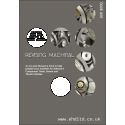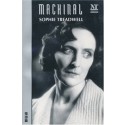Check items to add to the cart or select all
In this range of books, our writers have taken each play and picked five key scenes. They have then created a series of revision essays, notes and student handouts that will allow you to revise each of the five key scenes.These revision booklets are perfect to use either whilst you read the play, or as a revision and consolidation aid.
This Machinal booklet focuses upon Episodes 1, 2, 5, 8 and 9 of Sophie Treadwell's play. By working through the booklet, your A Level students will gain an in-depth revision of each scene. The booklet covers topics such as:
-The contextual and cultural messages within each scene and how these could be conveyed on stage.
-The original 1928 staging of this play.
-Using other previous productions of the play to gain inspiration for staging ideas, such as Alexander Tairov's 1933 production
-The key scenes in terms of expressionist influences
-Treadwell's structural devices and how these can be conveyed in a performance.
-Teadwell's use of elliptical dialogue
-The significance of symbols on stage such as the rubber gloves or the garbage bin.
-A wealth of practical ideas for a contemporary production of the play.
-Staging the different locations of the play such as the office, the home, the court room or the speakeasy.
-Analysing the lighting and sound choices within the key scenes and how to use these in an expressionist style.
-How to draw inspiration from expressionist directors such as Leopold Jessner or German expressionist film.
-Staging Treadwell's major themes such as the theme of religion at the end of the play, to the theme of condemnation.
-The language of different character types such as the language of the lawyers in the court room scene.
This Machinal booklet focuses upon Episodes 1, 2, 5, 8 and 9 of Sophie Treadwell's play. By working through the booklet, your A Level students will gain an in-depth revision of each scene. The booklet covers topics such as:
-The contextual and cultural messages within each scene and how these could be conveyed on stage.
-The original 1928 staging of this play.
-Using other previous productions of the play to gain inspiration for staging ideas, such as Alexander Tairov's 1933 production
-The key scenes in terms of expressionist influences
-Treadwell's structural devices and how these can be conveyed in a performance.
-Teadwell's use of elliptical dialogue
-The significance of symbols on stage such as the rubber gloves or the garbage bin.
-A wealth of practical ideas for a contemporary production of the play.
-Staging the different locations of the play such as the office, the home, the court room or the speakeasy.
-Analysing the lighting and sound choices within the key scenes and how to use these in an expressionist style.
-How to draw inspiration from expressionist directors such as Leopold Jessner or German expressionist film.
-Staging Treadwell's major themes such as the theme of religion at the end of the play, to the theme of condemnation.
-The language of different character types such as the language of the lawyers in the court room scene.
You may also be interested in the following product(s)
Machinal: A Teaching Folder (Eduq)
£72.99
|
Revising Machinal: Episodes 1-4, Design Aspects (Book 1)
£34.99
|
Machinal by Sophie Treadwell
£8.99
|









